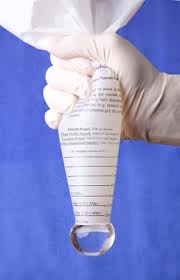
A novel breast implant insertion device is available that overcomes all of the concerns about manually handling and manipulating the implant. Known as the Keller Funnel, it is a cone-shaped device with an internal silicone lining. This allows the breast implant to be opened and placed directly into the funnel right out of the sterile box. Then by twisting the backside or larger end of the funnel, the silicone implant can be squeezed out of the end of the smaller end of the implant and through the incision right into the created breast pocket. The implant shell is less stressed as the forces of distortion or pressure on it are more evenly distributed throughout the entire implant shell. The silicone lining allows the implant to be lubricated so it can flow smoothly out of the funnel when under manual compression.
The Keller funnel is a significant advance for silicone breast augmentation. While it does add a very small cost to the procedure, it reduces the risk of infection and potentially even adds to the longevity of the implant’s durability.
Dr. Barry Eppley


